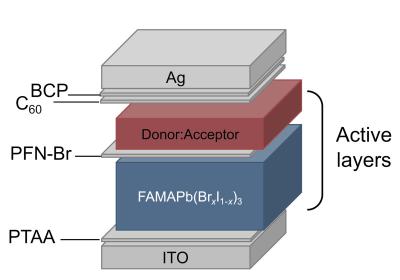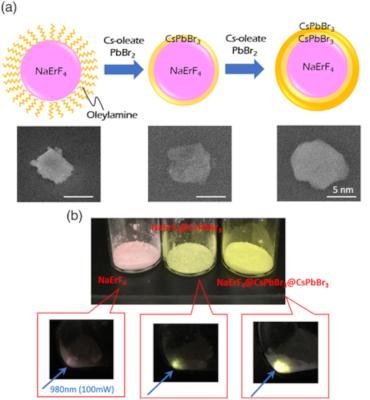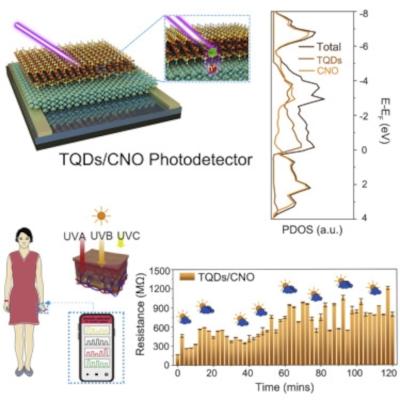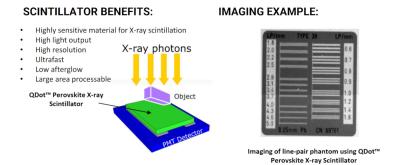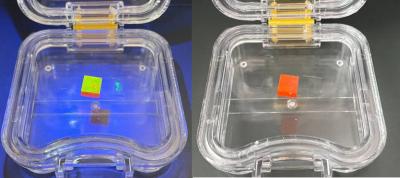Perovskites are materials that share a crystal structure similar to the mineral called perovskite, which consists of calcium titanium oxide (CaTiO3).
Depending on which atoms/molecules are used in the structure, perovskites can possess an impressive array of interesting properties including superconductivity, ferroelectricity, charge ordering, spin dependent transport and much more. Perovskites therefore hold exciting opportunities for physicists, chemists and material scientists.
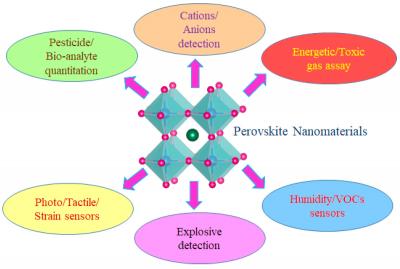
Sensors are devices that detect events that occur in the physical environment (like light, heat, motion, moisture, pressure, and more), and respond with an output, usually an electrical, mechanical or optical signal. The household mercury thermometer is a simple example of a sensor - it detects temperature and reacts with a measurable expansion of liquid. Sensors are everywhere - they can be found in everyday applications like touch-sensitive elevator buttons and lamp dimmer surfaces that respond to touch, but there are also many kinds of sensors that go unnoticed by most - like sensors that are used in medicine, robotics, aerospace and more.
Traditional kinds of sensors include temperature, pressure (thermistors, thermocouples, and more), moisture, flow (electromagnetic, positional displacement and more), movement and proximity (capacitive, photoelectric, ultrasonic and more), though innumerable other versions exist. sensors are divided into two groups: active and passive sensors. Active sensors (such as photoconductive cells or light detection sensors) require a power supply while passive ones (radiometers, film photography) do not.
Perovskite materials’ host of exciting properties, such as being rather tolerant to defects (unlike metal chalcogenides) and not requiring surface passivation to retain high quantum yields, make them especially suited for sensing applications. The sensitivity, selectivity, and stability of many perovskite nanomaterials has directed many researchers to devote the most attention to chemical sensors, but perovskites are suitable for other types as well. Perovskites are being studied by numerous research groups for use in various types of sensors.
Researchers develop self-powered perovskite photon-counting detectors
University of North Carolina at Chapel Hill researchers have demonstrated that self-powered polycrystalline perovskite photodetectors can rival the commercial silicon photomultipliers (SiPMs) for photon counting.
The new type of photon counting detector could have applications in consumer electronics, sensors, optical communication, radiation detection, and more. It could also offer safer medical imaging and enhance nighttime photography. The team's recent work could open up various new applications of photon counting for perovskites that use their unique defect properties. Compared to current technologies on the market, the team’s technology is reportedly more cost effective and does not require external power sources, broadening the scope of how the technology can be applied
Researchers develop efficient photodiode based on a tandem perovskite-organic solar cell architecture
Researchers from Eindhoven University of Technology and TNO at Holst Centre have developed a sensor that converts light into an electrical signal at an astonishing 200% efficiency – a seemingly impossible figure that was achieved through the exceptional nature of quantum physics.
SA schematic of the photodiode architecture
The team of scientists sees its invention potentially used in technology that monitors a person's vital signs (including heartbeat or respiration rate) from afar, without the need for anything to be inserted or even attached to the body.
Researchers use perovskites to develop near-infrared light detection technology
Researchers from Japan's Teikyo University of Science and Toin University of Yokohama, under the JST Strategic Basic Research Program PRESTO, have developed a new near-infrared light sensor by using perovskite materials that convert weak near-infrared light to visible light.
Near-infrared light is used in a wide range of applications, such as in infrared cameras (night vision cameras), infrared communication (wireless communication), optical fiber communication, remote control, and biometric authentication. The detection of weak light in the near-infrared region and improvement of sensitivity are indispensable for the advancement in optical communication technology, medical diagnosis, environmental monitoring, and other fields. Compound semiconductors (e.g., InGaAs) having an optimal absorption band of 900–1700 nm, are used to detect light in the near-infrared region. However, these systems are expensive because of their complicated manufacturing process that involves the use of rare metals and is limited by noise interference. Moreover, such semiconductors do not exhibit visible light detection accuracy comparable to that achieved using silicon (Si) and other compounds.
Researchers use perovskite and quantum dots to build an ultraviolet radiation measurement device
A team of researchers from China's Chinese Academy of Sciences (CAS), Jilin University and Beijing Institute of Technology, has used perovskite and quantum dots to build an ultraviolet radiation measurement device.
Measuring the intensity of ultraviolet light in outdoor conditions is important because more intense UV light can lead to faster sunburns and potentially to skin cancer in later years. In this new study, the researchers built a wearable device that can measure ultraviolet radiation in real-time and send the information to a smartphone.
Researchers design spray-coated perovskite hemispherical photodetector
Researchers from China's Jilin University have designed a spray coated spherical perovskite photonic sensor made of phenyl ethyl ammonium/formamidinium lead halide (PEA2FAn-1PbnX3n+1). The researchers utilized the perovskite formulations to regulate the crystallization rate. Cyclic spray-coating and the solution concentration were used to control the coating thickness from a few nanometers to hundreds of micrometers.
Sphere imagers featuring specific wavelength recognition and wide-angle imaging are required in order to meet the fast development pace of modern technology. However, it remains challenging to deposit high-quality photosensitive layers on sphere substrates from low-cost solution processes. In this recent study, the team demonstrated the feasibility of using a rapid spray-coating procedure to fabricate perovskite hemispherical photodetectors that can execute lens-free scanning at nearly 180°, considerably decreasing the reliance on complex optical components.
Researchers develop perovskite-based photodetectors with excellent efficiencies and response times
Researchers at the University of Toronto and the Barcelona Institute of Science and Technology recently reported new solution-processed perovskite photodetectors that exhibit remarkable efficiencies and response times. The photodetectors have a unique design that prevents the formation of defects between its different layers.
The researchers explained that there are applications for which fast photodetection is required in wavelength ranges beyond human vision. "Silicon, the legacy approach—and ideal for electronic readout—does not on its own unite high efficiency with high-speed, as a result of its indirect bandgap, a property of silicon's band structure that produces weak absorption (hence a need for thick silicon) in the near infrared", said University of Toronto's Amin Morteza Najarian.
Researchers design flexible X-Ray detectors based on molecular perovskites
Researchers from China's University of Science and Technology of China (USTC) and Shaanxi Normal University have synthesized a new molecular perovskite, DABCO-CsBr3 (DABCO = N,N′-diazabicyclo[2.2.2]octonium), for use in flexible X-ray detectors. The material was prepared from DABCO, CsBr, and HBr in aqueous solution and obtained in the form of colorless crystals.
The team found that DABCO-CsBr3 possesses good mechanical properties for use in flexible devices. Compared with the metal-free equivalent DABCO-NH4Br3, DABCO-CsBr3 has a stronger X-ray attenuation capability. The researchers built a flexible X-ray detector, using a poly(vinylidene fluoride) (PVDF) polymer matrix that was mixed with DABCO-CsBr3 to create a composite film. This film shows a linear relationship between the X-ray-induced current density and the X-ray dose rate. According to the team, the material could have applications in X-ray security screening systems or medical diagnostics.
Quantum Solutions starts offering evaluation samples of next-gen perovskite-QD based X-Ray Scintillators
UK-based Quantum Solutions started to ship evaluation samples of its next-gen perovskite quantum dots (pQD) X-Ray Scintillators. The company says that these scintillators offer very high sensitivity, high light output, high resolution, low afterglow and can be processed on large areas.
Quantum Solutions started developing these materials in 2020, and already managed to increase the light output (brightness) 10 times over. The company says that this is due to the unique perovskite structure that allows to tune the properties by composition, particle sizes/shapes, ligands, etc. The product already matches the performance of commercial CsI(Tl) and GADOX scintillators. The company is working with key customers in the medical field and non-destructive testing field, and are continuing to develop and customize the product.
Perovskite material for use in high-speed ionizing radiation detectors
Scientists at Russia's NUST MISiS, Moscow Institute of Physics and Technology, the Russian Academy of Sciences, RTU MIREA and Italy's CHOSE (Centre of Hybrid and Organic Solar Energy) have developed a halide perovskite-based material for use in high-speed and highly sensitive ionizing radiation detectors.
Perovskite responds to ionizing radiation in the form of light (luminescence) or current (as a photodiode). This is useful for high-speed and high-sensitivity components for high-energy particle registration. However, the structures inside the collider are exposed to high doses of radiation, which can damage them. Accordingly, components of ionizing radiation detectors must be resistant to such effects and retain their properties for a long time.
Researchers design halide perovskite nanocrystal memristors for neuromorphic computing
Researchers at ETH Zurich, the University of Zurich and Empa have developed a novel concept for a perovskite-based memristor that can be used in a far wider range of applications than existing memristors.
“There are different operation modes for memristors, and it is advantageous to be able to use all these modes depending on an artificial neural network’s architecture,” explains ETH postdoc Rohit John. “But previous conventional memristors had to be configured for one of these modes in advance.” The new memristors can now switch between two operation modes while in use: a mode in which the signal grows weaker over time and dies (volatile mode), and one in which the signal remains constant (non-volatile mode).
Pagination
- Previous page
- Page 3
- Next page


